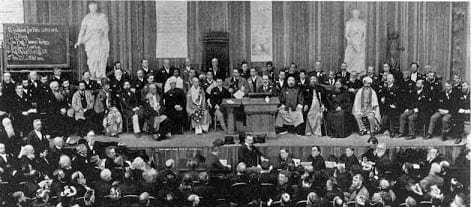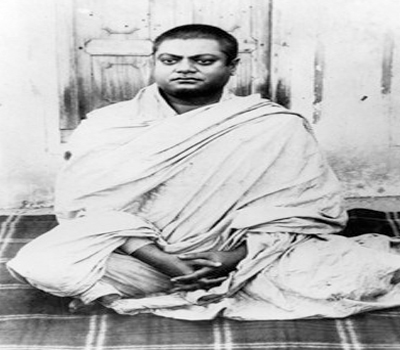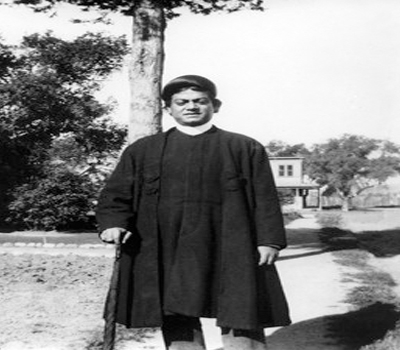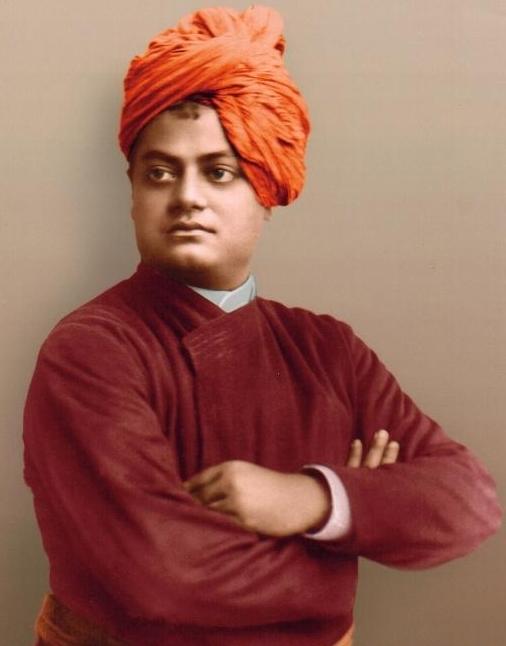WHEN SWAMI VIVEKANANDA was born 150 years ago, India was at the nadir of her long history due to centuries of foreign domination. Her national life centred on religion was stagnating. Even before reaching her lowest point, for centuries and as a natural reflex, people had coalesced in tightly held groups for their security and preservation of social and religious traditions. They erected walls of customs, superstitions, rites, and traditions around them and gradually each group was reduced to a closed and compact unit. They were extremely anxious to retain the forces of their tradition and culture against the odds created by military, political, economic, and other subordination. Somehow, within these walls national life held on tenuously. This hopelessly divided society urgently needed one who would break the walls open—without destroying the life within—while merging it into a collective whole so that it received new vigour and momentum. Apart from the threat of imperial subjugation and alien customs, the scientific temper of the age was also knocking on the walls. Again, the need of the hour was to combine the best elements of tradition with the scientific temper of the age. It is exactly this huge task that was undertaken by Swamiji to lead India on the path of growth and development. In order to accomplish this task, he reinterpreted ancient Indian traditional values, assimilated them with the spirit of the present age, and used the Vedanta philosophy to put them into the practical application in all spheres—personal, social, religious, political, and economic. He says:
But out of the past is built the future. Look back, therefore, as far as you can, drink deep of the eternal fountains that are behind, and after that, look forward, march forward and make India brighter, greater, much higher than she ever was. Our ancestors were great. We must first recall that. We must learn the elements of our being, the blood that courses in our veins; we must have faith in that blood and what it did in the past; and out of that faith and consciousness of past greatness, we must build an India yet greater than what she has been.1
It is this significant statement that we shall analyse and bring out its implications in this article.
Shaping of Vivekananda
Among the various influences that shaped the course of Swamiji’s life and actions, the most profound one was that of his master Sri Ramakrishna. Swamiji already had a natural intelligence for solving problems and helping others, and under his master this was developed into an unusual degree. Sri Ramakrishna also represented ancient India, traditional in its values, and firm in the belief of God’s existence. Swamiji, with a modern education and outlook, represented future India. Just as there was tremendous love and respect between the master and the disciple so was the process of assimilation of the old and new India happening first in the mind of Swamiji.
For this assimilation to crystallize Swamiji had to travel over the length and breadth of the nation, to have first-hand experience and understanding of the nation’s problems. He also had to become identified with the problems of the people and the country. These were his great days of parivrajya, wanderings, crucial in his development as a prophet. During this time he also found Sri Ramakrishna was always by his side in spirit—it was as if ancient and modern India were travelling together. In fact, Swamiji was undertaking this task at the express behest of his guru and God. During Sri Ramakrishna’s last days at Cossipore, ‘The Master wrote on a piece of paper, “Narendra will teach others.” Naren hesitated and said, “I won’t do that.” But the Master replied, “You shall have to do it.” Some time before he had told Naren, “My siddhis [powers] will manifest through you in time.”’2
Throughout his parivrajya he understood that this ancient land had, ‘withstood the shocks of centuries, of hundreds of foreign invasions, of hundreds of upheavals of manners and customs. It is the same land which stands firmer than any rock in the world, with its undying vigour, indestructible life.’3 Undergoing this process of understanding Swamiji points out: ‘I do not believe in reform; I believe in growth’ (3.213), and not in bits and pieces of reform. He wanted ‘root and branch reform’, nor the fanatical breaking down of things to remove the problems. Thus he patiently went about applying the remedy for India’s rejuvenation.
Assimilating Modern and Practical Ideas
He was not an ordinary reformer or philosopher, remaining satisfied with mere intellectual exercises but a faithful messenger of God with a definite mission. First of all, Swamiji realistically identified individual, religious, social, and economic problems, and his assessment was not academic in nature. After extensive travels he realized that some social evils were due to religious orthodoxy, fanaticism, intolerance, priestcraft, and superstitions. The hard and fast rules regarding many aspects of individual and social life had sapped the vitality of the people.
Hinduism is a bewildering mixture of many sects, practices, deities, sadhanas, and rituals. He traced the golden thread of unity running through all the vast array of different religions, denominations, practices, and sects and showed people the main principles of religion. Swamiji understood that the vitality of the people will rise naturally when unified. Instead of again investing that vitality in ritualism and small practices, he directed them to worship human beings as Narayanas, gods. Thus he went around the country and spoke with authority; for had he not been given the task by Sri Ramakrishna?
He also realized that lack of education—secular and spiritual—is the root cause of all weakness and misery of the Indian masses. Except for a few cities, the educational system was non-existent. In some parts of the country the vestiges of the old pathashalas, village schools, were still found to be somehow desperately clinging to life. However, the subjects taught as well as the teachers were not modern and so there was no scope for people to progress. These pathashalas were financed by the local benevolent people and their numbers were fast dwindling. The colonial government was more interested in exploitation than building schools in rural areas. That is why Swamiji wanted sannyasins, to go from village to village and door to door, to teach various modern subjects. He also encouraged the local rulers and rajas to start schools for the poor. Knowing that education was the one factor that would lift people up, he spoke of universal and free education. He declared: ‘It is only when the body is weak that these germs take possession of it and produce disease. Just so with the national life. It is when the national body is weak that all sorts of disease germs, in the political state of the race or in its social state, in its educational or intellectual state, crowd into the system and produce disease.
To remedy it, therefore, we must go to the root of this disease and cleanse the blood of all impurities’ (3.288). Today after a little more than a century, Swamiji’s dream of universal and free education has become a reality.
There was also the friction between castes, classes, and different races in India that kept the country divided. Swamiji saw this was setting back national development. Here, with his vast erudition and powers of conviction, he showed them the common grounds of ancestry, race, and the real meaning of castes. He said: ‘The time has come when for the well-being of ourselves, for the well-being of our race, we must give up all our little quarrels and differences. Be sure, these quarrels are entirely wrong ; they are condemned by our scriptures, forbidden by our forefathers; and those great men from whom we claim our descent, whose blood is in our veins, look down with contempt on their children quarrelling about minute differences’ (ibid.).
Swamiji correctly diagnosed that people had lost faith in themselves. Here he invoked the practical teachings of the Vedanta, which teaches faith in the guru and the shastras, but with a modification: he preached faith in oneself first. ‘Faith in ourselves will do everything. I have experienced it in my own life, and am still doing so; and as I grow older that faith is becoming stronger and stronger. He is an atheist who does not believe in himself. The old religion said that he was an atheist who did not believe in God. The new religion says that he is an atheist who does not believe in himself ’ (2.301). Thus Swamiji preached faith in oneself as a new religion by applying the principles of Vedanta to work for the amelioration of the nation.
But Swamiji points out that this faith in oneself is not selfish faith, that is, faith in one’s own ego. As the individual soul is the reflection of Brahman, one should have faith in this absolute Reality that runs through and pervades everything, and which is the source of infinite purity, freedom, love, and power. It is to have faith in one’s own Divinity.
Appealing to the Ancient Indian Tradition
Swamiji knew that social or national improvement has to have a solid foundation. All improvements and developments are secondary and will become useless if there is no religion and spirituality. That Swamiji blends the traditional wisdom with the spirit of modernity is once again reflected in his approach to religion. While recognizing the necessity of religion in human life, he says stirringly:
We have seen that our vigour, our strength, nay, our national life is in our religion. I am not going to discuss now whether it is right or not, whether it is correct or not, whether it is beneficial or not in the long run, to have this vitality in religion, but for good or evil it is there; you cannot get out of it, you have it now and for ever, and you have to stand by it, even if you have not the same faith that I have in our religion. You are bound by it, and if you give it up, you are smashed to pieces. That is the life of our race and that must be strengthened. You have withstood the shocks of centuries simply because you took great care of it, you sacrificed everything else for it. Your forefathers underwent everything boldly, even death itself, but preserved their religion. Temple after temple was broken down by the foreign conqueror, but no sooner had the wave passed than the spire of the temple rose up again. Some of these old temples of Southern India and those like Somnath of Gujarat will teach you volumes of wisdom, will give you a keener insight into the history of the race than any amount of books. Mark how these temples bear the marks of a hundred attacks and a hundred regenerations, continually destroyed and continually springing up out of the ruins, rejuvenated and strong as ever! That is the national mind, that is the national life-current. Follow it and it leads to glory. Give it up and you die; death will be the only result, annihilation the only effect, the moment you step beyond that life-current (3.289).
In this way Swamiji showed us our real source of strength and how to develop it. To him everything—individual, social, and national—should stand on this identity and character of the nation.
He spoke of the importance of culture and refinement. He said that even those with education behaved like animals if they are merely scratched. He wanted people to know that with all the knowledge they can acquire they also needed the stability of culture. It is culture that gives dignity and prestige. He therefore encouraged the study of Sanskrit saying that with Sanskrit learning comes culture that can withstand shocks. This is the one language that could also unify the people into developing a national consciousness.
He encouraged the cottage and village industries of manufacturing handicrafts and items of daily use, which would take care of their domestic and local wants, bring down unemployment, and at the same time help preserve traditional arts and crafts. He also encouraged the setting up of vocational training schools. This is one of the reasons he went to the US; to obtain help and know-how for local industries to develop. Industrialists and traders were requested to look for local materials and processes that could create wealth and employment.
Raising the Masses
All through his travels Swamiji became acutely aware of the need to raise the masses. These people, long neglected and exploited, had to be raised for India to rise. He said that those who were educated at their expense and yet did nothing for them were traitors. He had little hope in the rich and moneyed people and spoke of the real India that lived in the villages. It was his first-hand experience of dehumanizing social, economic, and religious conditions of the Indian masses that led him to reinterpret Vedanta. Swamiji’s emphasis on the Vedantic identification of the human being as the true abode of the Divine was to exalt the dignity of a human being. He realized that it would be of no use to have the knowledge of Vedanta unless and until it was reflected in compassionate behaviour towards the downtrodden suffering from hunger, ignorance, disease, and prejudice. Swamiji realized the stark reality of Indian masses as he wrote:
The nation is sinking, the curse of unnumbered millions is on our heads—those to whom we have been giving ditch-water to drink when they have been dying of thirst and while the perennial river of water was flowing past, the unnumbered millions whom we have allowed to starve in sight of plenty, the unnumbered millions to whom we have talked of Advaita and whom we have hated with all our strength, the unnumbered millions for whom we have invented the doctrine of Lokachara (usage), to whom we have talked theoretically that we are all the same and all are one with the same Lord, without even an ounce of practice (3.431).
Again, his famous phrase ‘jiva is Shiva’ indicates that he held humankind in high esteem. He was not a so-called spiritual guru whose only task is to preach the spiritual truth to the common people, but a karma-yogi of highest order, who initiated work towards their uplift. Accordingly, he responded to the challenge by including in the range of his services to the masses, economic, social, and spiritual benefits. Grounded as he was in the highest plane of Vedanta he made a down-to-earth approach to the problems of the masses: ‘What we want is not so much spirituality as a little of the bringing down of the Advaita into the material world. First bread and then religion. We stuff them too much with religion, when the poor fellows have been starving. No dogmas will satisfy the cravings of hunger’ (3.432).
In today’s parlance, Swamiji can be called an apostle of ‘human rights’. If we regard the innate dignity of a human being as the foundation of human rights, then Swamiji obviously lays stress on this dignity because of the inherent Divinity of humankind taught in the Vedanta. Vedanta was for long ages preached to highly qualified aspirants, but he made the basic principles simple to understand and preached it to one and all. This was an astounding development in Vedanta philosophy. No longer was it reserved for a select few but for all. This was important because it had to be taught to all types of minds who could understand it. The second step of practicality was applying Vedanta to the concrete problems of social life. It was no longer the preserve of monks and pundits but of the common people in every walk of life. It is on account of this Vedantic analysis of human dignity that he can be regarded as a human rights thinker. And secondly, Vivekananda can also be said to be a human rights activist of highest order for his sincere crusade against all forms of oppression, prejudice, and ignorance. In keeping with his Vedantic understanding of human dignity, he dedicated his life to the service of what he called ‘God in human form’. His practical Vedanta thus reconciles spirituality with material life and thereby aims at fulfilling both the secular and spiritual needs of society.
What the country also needed was to learn how to work conjointly in an organized method. He set up an organization called the Ramakrishna Order to give his ideals a concrete shape and to lead the disorganized society. By organizing the monks, which was first done by Buddha and later formalized by Acharya Shankara, Swamiji brought the old methods into a new type of organization for the present age. The tremendous power of unselfishness would not only bring good to society but also bring people to their senses when they saw monks, ordinarily venerated, doing the work that they were supposed to do. Today the Ramakrishna Order, with its various branches, acts like a template for many monastic and non-monastic organizations that are doing good to society in various fields.
Bringing Hope
Swamiji knew that as society progresses there will always be pressures, exploitation, unhappiness, and misery in the lives of individuals. This scenario is amply evident in today’s world where stress and anxiety are ruining the mental health of people. Coping with oneself and the world around is becoming a daily battle. It is here that Swamiji brings in the knowledge of the Atman as the sure antidote to overcome all problems.
Vedanta insists that every person has infinite power, purity, and bliss that need to be manifested. Swamiji says that it is the veil of ignorance that needs to be removed to realize there is no darkness around and we possess all the powers of the universe. It is the greatest ‘error’ to think one’s own self as weak, sinful, miserable, and impure. Again, when one says that one is a mortal being, one is telling the biggest of all lies. Vedanta teaches strength. Swamiji says:
Think not that you are weak and miserable. Almighty, arise and awake, and manifest your own nature. It is not fitting that you think yourself a sinner. It is not fitting that you think yourself weak. Say that to the world, say it to yourselves, and see what a practical result comes, see how with an electric flash everything is manifested, how everything is changed. Tell that to mankind, show them their power. Then we shalllearn how to apply it in our daily lives (2.304).
Vedanta preaches that the one Atman pervades all life and existence. The difference we observe is due to our ignorance, which has separated us from the world and universal life. When life and the world are perceived from the standpoint of Vedanta, no differences are observed. Swamiji further argues that what makes for oneness is truth. Love is truth, for it integrates and binds all creation together. On the contrary, hatred makes for multiplicity and distinctions. All beings are but the reflections of the one Reality. He writes: ‘Love binds, love makes for that oneness. You become one, the mother with the child, families with the city, the whole world becomes one with the animals.For love is Existence, God himself; and all this is the manifestation of that One Love, more or less expressed. The difference is only in degree, but it is the manifestation of One Love throughout’ (2.304).
Accordingly, Swamiji argues that in love, one discovers oneself in the object of love. Thus one who loves is identical with the one who is loved—both are reflections of the same Brahman.
Using the Inherent Urge for Religion
Religion and religious thought has been the one guiding factor in human societies. This urge for religion is innate and is why all cultures have some form of religious belief. People are not just slaves of the mundane world, remaining satisfied only with materialistic needs, but aspire for a higher kind of life. This craving to go beyond this present existence and embrace the Divine is the urge called religion. Hence the essence of religion does not lie in the external world but within the human heart; this is a growth from within. The task of any religion is to guide one to the goal.
Historically speaking, there are different religions having different beliefs, codes, and rites, and they have been quarrelling with each other throughout the ages. Though religion has brought peace, love, and happiness, nothing has created so much hatred, enmity, and horror among the people as religion has. Further, the cause of such disaster is that each religion claims its own doctrine as superior, and hence it has exclusive rights to live and expand even at the cost of so-called ‘other’ religions. Swamiji realized that despite open clashes and conflicts among religions, no religion has died out; rather each of them has continued to sustain and expand in different corners of the world.
Swamiji declared that as there are many types of minds there will be many types of religions in the world. Each religion has its share of ground to operate. Swamiji said it is a truism to have variation in thought, and it is futile to expect that all religions, sects, or individuals would conform to the same set of ideas, beliefs, and codes. The variation in thoughts must be there, for it is the sign of life. The differences of opinion are natural and a sign of healthy living. ‘If you and I and all who are present here were to think exactly the same thoughts, there would be no thoughts for us to think. We know that two or more forces must come into collision in order to produce motion. It is the clash of thought, the differentiation of thought, that awakes thought. … Whirls and eddies occur only in a rushing, living stream. There are no whirlpools in stagnant, dead water’ (2.363).
Therefore Swamiji was the first to speak about interreligious dialogue in the West and intra-religious dialogue in Hinduism to iron down the differences. He said: ‘I believe that they [religions] are not contradictory; they are supplementary. Each religion, as it were, takes up one part of the great universal truth, spends its whole force in embodying and typifying that part of the great truth. It is, therefore, addition; not exclusion. That is the idea’ (2.365).
But then, a question arises: How can all the variety of views be true at the same time? Just as the photograph of a temple taken from different angles and corners look different, but represent the same temple, similarly, we perceive the truth from different sides. The perception of truth is defined by birth, education, experience, and surroundings. Similarly, the representations of God by religions may appear contradictory but ultimately they supplement each other.
This is where Swamiji brings in the Vedanta, which can become the rationale of all religions because it is broad and catholic in outlook and is capable of accommodating all individual viewpoints within its fold. It is open to all individuals irrespective of caste, nationality, gender, and race. Vedanta will be the essence of all religions, for Swamiji believed that a person never progresses from error to truth, but from truth to truth, from lower truth to higher truth. The watchword of Vedanta, according to Swamiji, is acceptance and not exclusion. Acceptance is different from toleration. For him, it is ‘blasphemy’ to think that one who belongs to a particular religion allows the person of another religion to practise his or her own religion. In this sense, toleration implies something is being allowed inspite of being wrong. Swamiji suggests we adopt the policy of acceptance. He clarifies:
I accept all religions that were in the past, and worship with them all; I worship God with every one of them, in whatever form they worship Him. I shall go to the mosque of the Mohammedan; I shall enter the Christian’s church and kneel before the crucifix; I shall enter the Buddhistic temple, where I shall take refuge in Buddha and in his Law. I shall go into the forest and sit down in meditation with the Hindu, who is trying to see the Light which enlightens the heart of every one (2.374).
These are some of the areas Swami Vivekananda applied his prophetic intellect and heart to uplift humankind. We must also not forget that Sri Ramakrishna said his powers would in time manifest through Swami Vivekananda. As the world is progressing to newer levels and encountering bigger problems, we are witnessing a greater manifestation of that power in the world. 150 years ago India was at the nadir but she kept moving up and will, as predicted by Swami Vivekananda, reach her zenith. We can bring about this glorious age by working hard to implement his ideas.
(Source: Prabuddha Bharatha Special Edition January 2014)
References
1.The Complete Works of Swami Vivekananda, 9 vols (Calcutta: Advaita Ashrama, 1–8, 1989; 9, 1997), 3.285–6.
2. His Eastern and Western Disciples, The Life of Swami Vivekananda, 2 vols (Kolkata: Advaita Ashrama, 2008), 1.182.
3. Comp lete Works, 3.285.







Leave A Comment